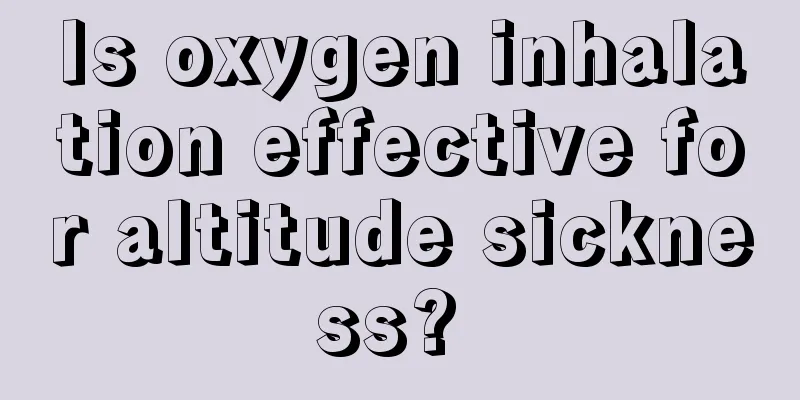Is oxygen inhalation effective for altitude sickness?

|
Plateaus are continental areas that rise above a certain range from the horizon. Plateaus account for a large proportion of my country's area. For example, the Qinghai-Tibet Plateau is a typical plateau landform with an average altitude of more than 4,000 meters. Hypoxia occurs in this area, and the health problems caused by this are also called altitude sickness. When this kind of reaction occurs, it is necessary to seek timely treatment. Let’s take a look at whether oxygen inhalation is effective for altitude sickness. The oxygen content on the plateau is lower than on ordinary ground. The higher the altitude, the more oxygen is lacking. Moreover, for people who go to high altitude for the first time, since they adapt to the oxygen concentration on ordinary ground, their hemoglobin in the body is relatively low. If they live in the plateau for a certain period of time, their blood will become rosy because of the increase in hemoglobin. In fact, altitude sickness does not require oxygen. It depends on the specific symptoms. Altitude sickness refers to a variety of pathological reactions that occur when the human body is rapidly exposed to a low-pressure, low-oxygen environment. It is a common disease unique to plateau areas. Common symptoms include headache, insomnia, loss of appetite, fatigue, and difficulty breathing. Headache is the most common symptom, often with throbbing pain in the forehead and temporal areas, which worsens at night or when getting up in the morning. Increasing lung ventilation, such as breathing through the mouth and light activity, can relieve headaches. 1. Mild symptoms No treatment is required, and the symptoms usually disappear on their own after 1 to 2 weeks of adaptation. For those with more severe reactions, symptomatic treatment with analgesics, sedatives, antiemetics, etc. may be used as appropriate. "Amiproben" and "Xionin" can also be used for headaches and vomiting. The latter mainly acts on the vomiting center and has no inhibitory effect on other areas. 2. Severely ill patients Oxygen inhalation can be given intermittently or continuously. Long-term oxygen inhalation is not recommended because it hinders the body's adaptation to the low oxygen environment. If necessary, mild diuretics such as acetazolamide or oral administration of aminophylline can be used for treatment. The basic principle of treatment is early diagnosis to avoid the development of severe altitude sickness. There is no special treatment for mild patients, and most people's symptoms will naturally ease or disappear after they fully adapt within 12 to 36 hours. |
<<: What does urine protein addition and subtraction mean
>>: There is hemoglobin in the urine
Recommend
What are the causes of gastric cancer
Gastric cancer can occur at any age, but is more ...
Indications and contraindications for sputum suction
Suctioning refers to the process of sucking out s...
Why can't lung cancer patients eat
Why can’t people with lung cancer eat? There are ...
Do I need to take anti-inflammatory drugs if acne is infected
Every day, many people have pimples on their face...
How to make an emergency plan for infusion reaction?
Infusion is the most commonly used injection trea...
What happened to my arm swelling after breast cancer surgery? How to treat it?
What happens if my arm is swollen after breast ca...
Lung cancer patients have their own unique cough characteristics. Have you ever experienced it?
Lung cancer is a cancer that is difficult to trea...
What can I drink to detox?
Many people's bodies have accumulated a lot o...
What kind of tea is good to drink after the beginning of autumn
The Beginning of Autumn is a well-known solar ter...
Can early testicular cancer be cured?
For testicular cancer that is discovered in the e...
What are the typical symptoms of early lung cancer? Three common typical symptoms of early lung cancer
You may not know much about the symptoms of lung ...
Prognosis of non-Hodgkin's lymphoma
With the continuous improvement of treatment meth...
May I ask what kind of food can prevent radiation
Recently, many people have suffered great harm du...
What can't you eat during breast cancer chemotherapy?
What should not be eaten during breast cancer che...
How long do sperm live after ejaculation?
After a man's sperm is ejaculated into a woma...









